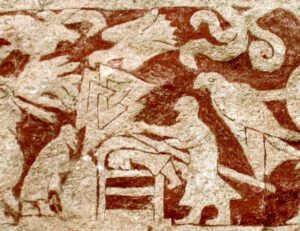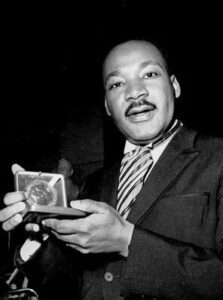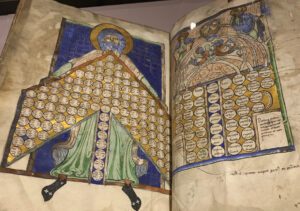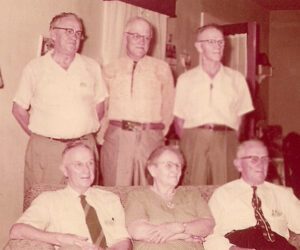
30 Jun Genealogist for Hire- Newsletter- July 2, 2022

Contents
- 1 GENEALOGISTS KNOW THAT AMERICA ONCE INVADED RUSSIA?
- 2 GENEALOGISTS AND THE BLOOD EAGLE RITUAL
- 3 GENEALOGISTS KNOW WHO NOMINATED MLK FOR THE NOBEL PEACE PRIZE?
- 4 GENEALOGISTS ASK “SO IS THERE A BOOK WHERE I CAN LOOK AND SEE IF I CAN MARRY MY COUSIN?”
- 5 GENEALOGISTS WONDER SHOULD YOU TRUST YOUR DOCTOR?
- 6 GENEALOGISTS TAKE NOTE OF ABRAHAM LINCOLN’S GIFT OF REVOLVERS TO KING FREDERICK VII OF DENMARK
- 7 GENEALOGISTS KNOW YOUR ANCESTORS ARE WAITING FOR YOU TO DISCOVER THEM!
GENEALOGISTS KNOW THAT AMERICA ONCE INVADED RUSSIA?
The United States Invasion of Russia Was a Yearlong Freezing Hell for the Troops
Fighting a war in Russia during the winter is never a good idea, and yet time and again, people keep trying. The United States is as guilty of it as Napoleon was.
In November of 1918, much of the world was jubilantly celebrating the end of World War I, the “war to end all wars.” As those celebrations caught the attention of newspapers and newsreels all over the United States, there was one group of Americans whose war hadn’t yet ended.
Around 5,000 American soldiers were part of an allied expedition to intervene in the ongoing Russian civil war against the “Red” Bolshevik forces. For a little over a year, the American Expeditionary Force in North Russia fought to give the anti-Bolshevik “White” Russians the upper hand.
As summer turned to fall in 1918, the combined forces of Britain, France, Italy, the United States and the rest of their allies were making drastic advances against their World War I enemies. Things were looking bleak for the Central Powers of Germany, Austria-Hungary, the Ottoman Empire and Bulgaria.
In France, the allied forces had pushed the German Army back to the Hindenburg Line, nearly pushing it out of France altogether. Soon, German soldiers and sailors would revolt against the continued war, the Kaiser would be forced to abdicate, and an armistice would be negotiated to end the war.
Things were looking good for the allies, but the Russians, who had negotiated a separate peace in March of 1918, were still locked in a brutal struggle for who would control Russia. Britain, France and the United States had sent the Tsar 110,000 new rifles and other war materials to help keep the Russian Empire in World War I. Since the Russian military was unable to distribute any of it, Russia dropped out anyway.
Those arms and supplies were sitting in a warehouse in the northern city of Arkhangelsk. The “Polar Bear Expedition,” as the mission had come to be called, was simple on paper. They were to capture the stored weapons and secure an area large enough for the White Russians to form a stable government and army. Neither of those things happened.
The Americans, at the request of the British and French, landed in the city in September 1918. They found the city was already occupied by the British, and they also found that the weapons cache was already discovered by the Bolsheviks, who’d made off with them.
To make matters worse, a force of Czech and Slovak armies called the Czech Legion was in danger of being overrun while fighting along the Trans-Siberian Railway, a front that was hundreds of miles long. The American 339th Infantry, which was largely overcome with Spanish flu, was sent to relieve them.
The Americans, with British help, broke out of the Arkhangelsk perimeter and into Bolshevik territory. For six weeks, they fought their way along the Dvina River, but at the end of it, they found themselves just as stretched out as the Czech Legion. With winter beginning to set in, they had to do something fast.
With the Czech Legion firmly out of reach, the allies tried to raise an anti-Bolshevik army from members of the local population. When winter arrived in force, the allies were without recruits. Then came the Bolshevik counterattack.
In October 1918, the Red armies inflicted a large number of casualties on the Americans, who had expected a relatively calm winter. Instead, the Red assault forced the allies to retreat back toward Arkhangelsk. They were forced to give up all their gains and take a loss of 10% of their force: 110 killed in combat, 30 missing and 70 dead from Spanish flu.
By the time the Polar Bears had secured their position in Arkhangelsk, World War I had ended in an armistice, and the port of Arkhangelsk was frozen over. Even though the war was over, the Americans in Russia would have to survive through the winter until a ship could exfiltrate them.
The soldiers were getting restless, subject to defending an area the size of Texas and Oklahoma alongside Russians who seemed disinterested in the outcome of the battle. The Americans struggled to tell the difference between a Bolshevik and an anti-Bolshevik. All the while, they were inundated by ambushes and Red propaganda, asking: “If the war is over, why are you still here?”
he Red army continued its push against the foreigners throughout the winter. Its new offensive was so successful, the allies decided that their ultimate goal was getting out of there as soon as possible. It wasn’t until June 1919 that the USS Des Moines steamed into the port and picked up the Polar Bears.
In all, the Americans lost 344 dead to combat and disease, along with another 305 wounded. They even left 125 men behind. These men wouldn’t be returned home until the Veterans of Foreign Wars was allowed to retrieve their remains inside the Soviet Union in 1929.
Military.com | By Blake Stilwell
 GENEALOGISTS AND THE BLOOD EAGLE RITUAL
GENEALOGISTS AND THE BLOOD EAGLE RITUAL
Torf-Einarr’s ritual execution of Harald Fairhair’s son, Halfdan Long-Leg, in the late 9th century was described in Snorri Sturluson’s Heimskringla contains an account of the same event described in Orkneyinga saga, with Einarr performing the deed himself:
“Afterward, Earl Einarr went up to Halfdan and cut the “blood eagle” on his back, in this fashion that he thrust his sword into his chest by the backbone and severed all the ribs down to the loins, and then pulled out the lungs; and that was Halfdan’s death.”
The picture above shows detail from Stora Hammars I, Sweden shows a man lying on his belly with another man using a weapon on his back.
 GENEALOGISTS KNOW WHO NOMINATED MLK FOR THE NOBEL PEACE PRIZE?
GENEALOGISTS KNOW WHO NOMINATED MLK FOR THE NOBEL PEACE PRIZE?
The first nomination for Martin Luther King Jr. arrived at the Norwegian Nobel Committee in 1963. The Norwegian Nobel Committee, awarder of the Nobel Peace Prize since 1901, received this nomination from an earlier Nobel Peace Prize Laureate, American Friends Service Committee (The Quakers) in Philadelphia, USA, awarded the Nobel Peace Prize in 1947. The nomination was dated 31 January 1963.
 GENEALOGISTS ASK “SO IS THERE A BOOK WHERE I CAN LOOK AND SEE IF I CAN MARRY MY COUSIN?”
GENEALOGISTS ASK “SO IS THERE A BOOK WHERE I CAN LOOK AND SEE IF I CAN MARRY MY COUSIN?”
The consanguinity tree includes extra branches listing brothers and sisters and their offspring. It is complemented by a ‘tree of affinity’ diagram on the facing page, showing family relationships through marriage. Consanguinity and affinity trees were often included in legal textbooks, where they were used to determine inheritance issues and the legality of marriages. In the richly painted example, the diagram is shown supported by a majestic figure who may represent God the Father governing all human generations.
 GENEALOGISTS WONDER SHOULD YOU TRUST YOUR DOCTOR?
GENEALOGISTS WONDER SHOULD YOU TRUST YOUR DOCTOR?
Christian VII (29 January 1749 – 13 March 1808) was a monarch of the House of Oldenburg who was King of Denmark–Norway and Duke of Schleswig and Holstein from 1766 until he died in 1808.
Christian VII’s reign was marked by mental illness; for most of his reign, Christian was only nominally King. His royal advisers changed depending on who won power struggles around the throne.
Dr. Johann Friedrich Struensee had managed to gain the King’s confidence and affection. The King’s ministers were pleased with Struensee’s influence on the King, who began making fewer embarrassing “scenes”. Upon the court’s return to Copenhagen in January 1769, Struensee was appointed personal physician to the King. In May, he was given the honorary title of State Councillor, which advanced him to the class of the third rank at court. In addition, Struensee wrote an important report on the King’s mental health.
First, he reconciled the King and queen. At first, Queen Caroline Matilda (pictured) disliked Struensee, but she was unhappy in her marriage, neglected and spurned by the King, and affected by his illness. But Struensee was one of the few people who paid attention to the lonely queen and seemed to do his best to alleviate her troubles. Over time her affection for the young doctor grew, and by spring 1770, he became her lover; a successful vaccination of the baby crown prince in May further increased his influence.
Struensee was named royal adviser (forelæser) and konferensråd on 5 May 1770. On 15 September, the King dismissed Chancellor Bernstorff, and on 18 December, Struensee appointed himself as privy counselor, consolidating his power and starting the 16 months referred to as the “Time of Struensee”.
When in the year the King sank into a condition of mental torpor, Struensee’s authority became paramount.
From 1770 to 1772, his court physician Johann Friedrich Struensee was the country’s de facto ruler and introduced progressive reforms signed into law by Christian VII.
A palace coup took place in the early morning of 17 January 1772, Struensee and Queen Caroline Matilda were arrested in their respective bedrooms, and the perceived liberation of the King, who was driven around Copenhagen by his deliverers in a gold carriage, was received with universal rejoicing. The chief charge against Struensee was that he had usurped the royal authority in contravention of the Royal Law (Kongelov). He defended himself with considerable ability and, at first, was confident that the prosecution would not dare to lay hands on the queen. He denied that their liaison had ever been criminal. The queen was taken as a prisoner of state to Kronborg Castle.
On 27 April, Struensee was first condemned to lose his right hand and then be beheaded; his body was then drawn and quartered. Caroline Matilda was divorced and banished to Celle, Hanover, where she died at the age of twenty-three from scarlet fever in 1775.
 GENEALOGISTS TAKE NOTE OF ABRAHAM LINCOLN’S GIFT OF REVOLVERS TO KING FREDERICK VII OF DENMARK
GENEALOGISTS TAKE NOTE OF ABRAHAM LINCOLN’S GIFT OF REVOLVERS TO KING FREDERICK VII OF DENMARK
These Colt revolvers with engravings were given to the king by an envoy of Abraham Lincoln, who had recently been elected president. At the time the revolver was unknown in Europe.
 GENEALOGISTS KNOW YOUR ANCESTORS ARE WAITING FOR YOU TO DISCOVER THEM!
GENEALOGISTS KNOW YOUR ANCESTORS ARE WAITING FOR YOU TO DISCOVER THEM!
Reach out to Dancestors and let us research, discover, and preserve your family history. No one is getting any younger, and stories disappear from memory every year and eventually from our potential ability to find them. Paper gets thrown in the trash, books survive! So do not hesitate, and call to me @ 214-914-3598.


 GENEALOGISTS AND THE BLOOD EAGLE RITUAL
GENEALOGISTS AND THE BLOOD EAGLE RITUAL GENEALOGISTS KNOW WHO NOMINATED MLK FOR THE NOBEL PEACE PRIZE?
GENEALOGISTS KNOW WHO NOMINATED MLK FOR THE NOBEL PEACE PRIZE? GENEALOGISTS ASK “SO IS THERE A BOOK WHERE I CAN LOOK AND SEE IF I CAN MARRY MY COUSIN?”
GENEALOGISTS ASK “SO IS THERE A BOOK WHERE I CAN LOOK AND SEE IF I CAN MARRY MY COUSIN?” GENEALOGISTS WONDER SHOULD YOU TRUST YOUR DOCTOR?
GENEALOGISTS WONDER SHOULD YOU TRUST YOUR DOCTOR? GENEALOGISTS TAKE NOTE OF ABRAHAM LINCOLN’S GIFT OF REVOLVERS TO KING FREDERICK VII OF DENMARK
GENEALOGISTS TAKE NOTE OF ABRAHAM LINCOLN’S GIFT OF REVOLVERS TO KING FREDERICK VII OF DENMARK GENEALOGISTS KNOW YOUR ANCESTORS ARE WAITING FOR YOU TO DISCOVER THEM!
GENEALOGISTS KNOW YOUR ANCESTORS ARE WAITING FOR YOU TO DISCOVER THEM!